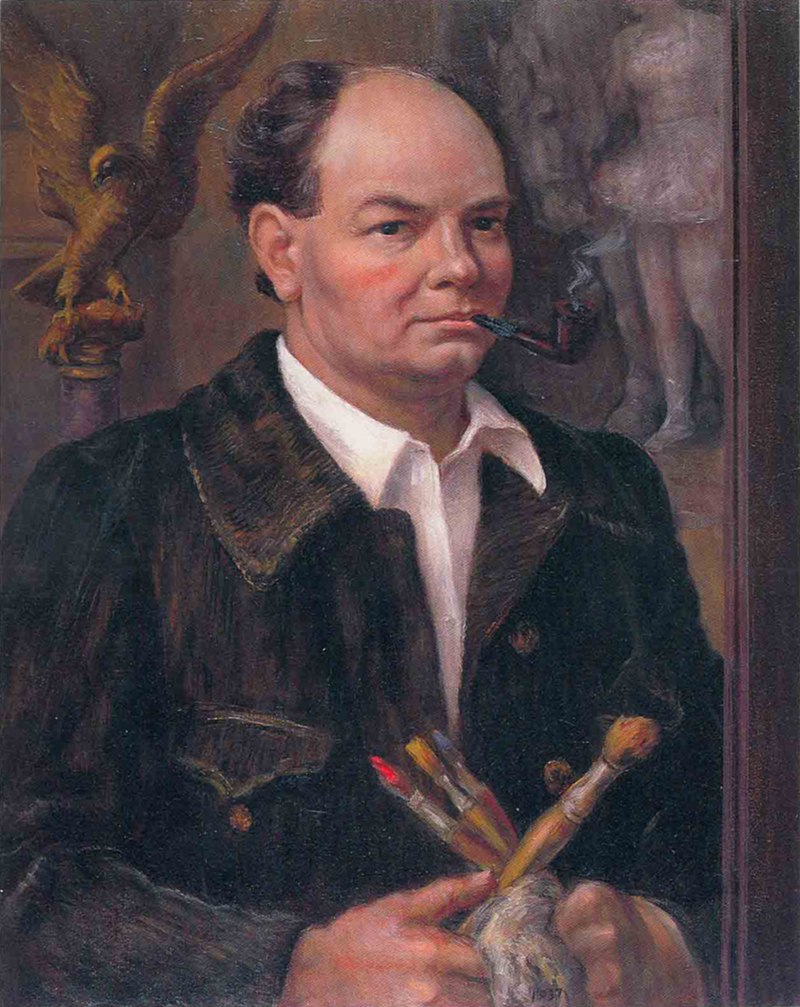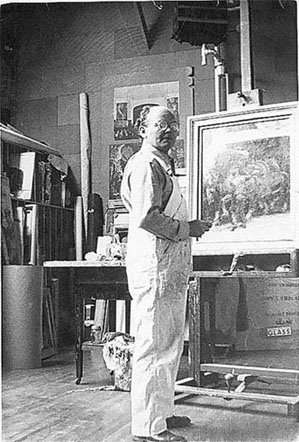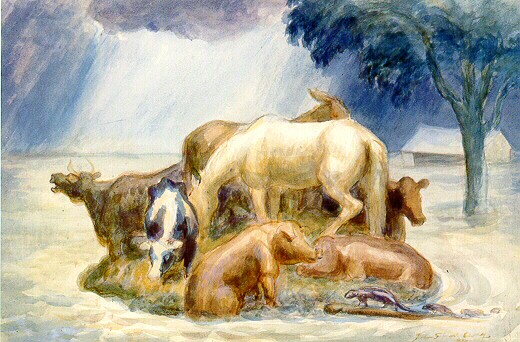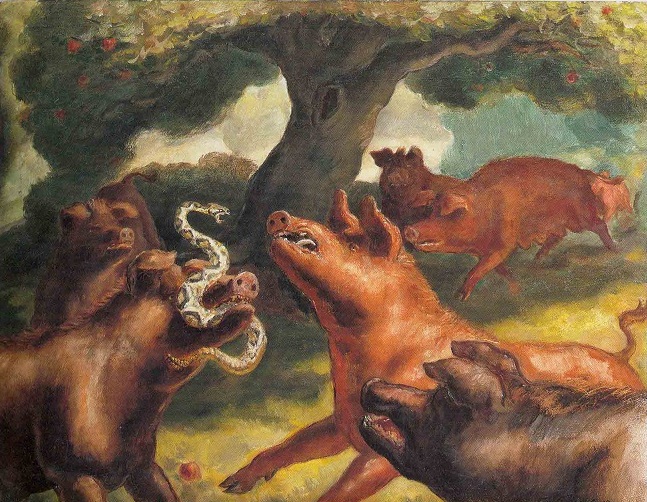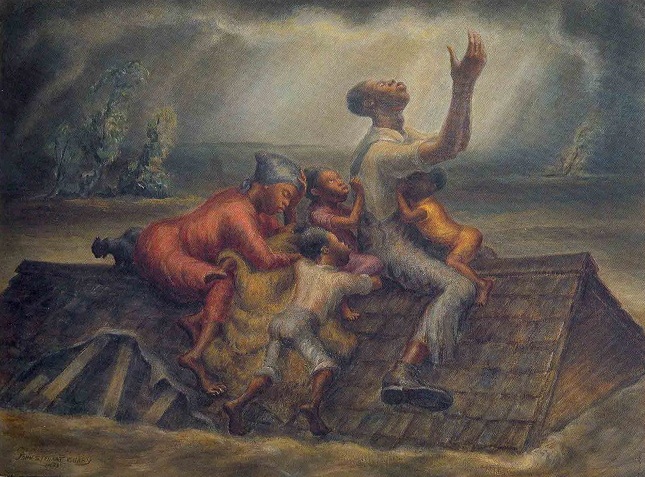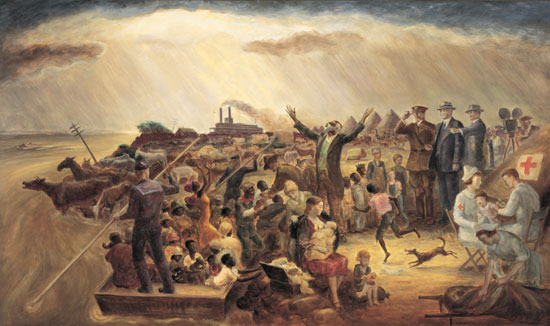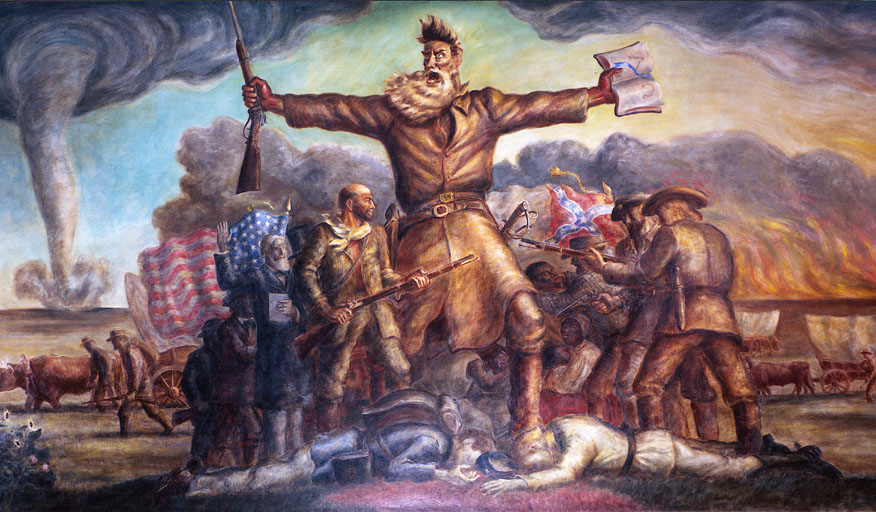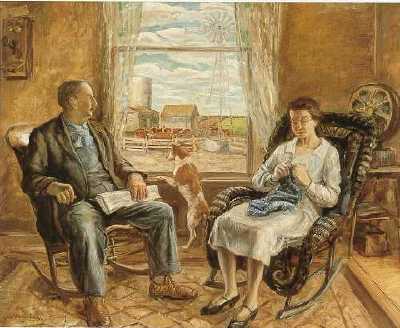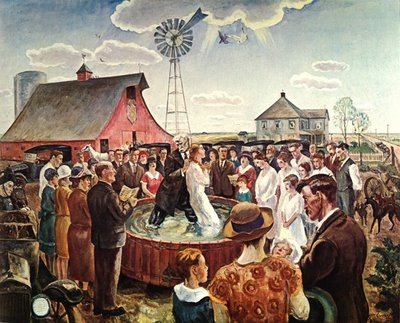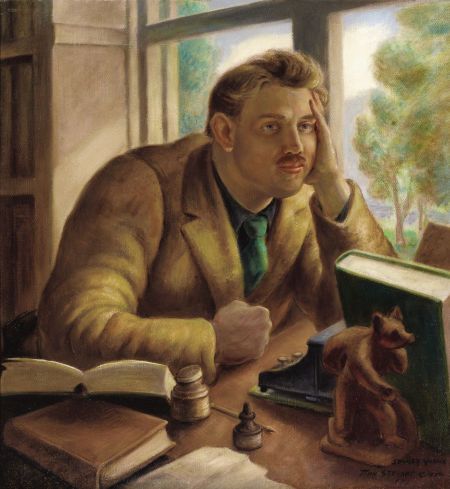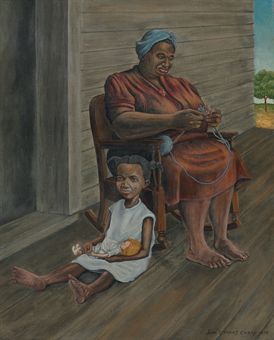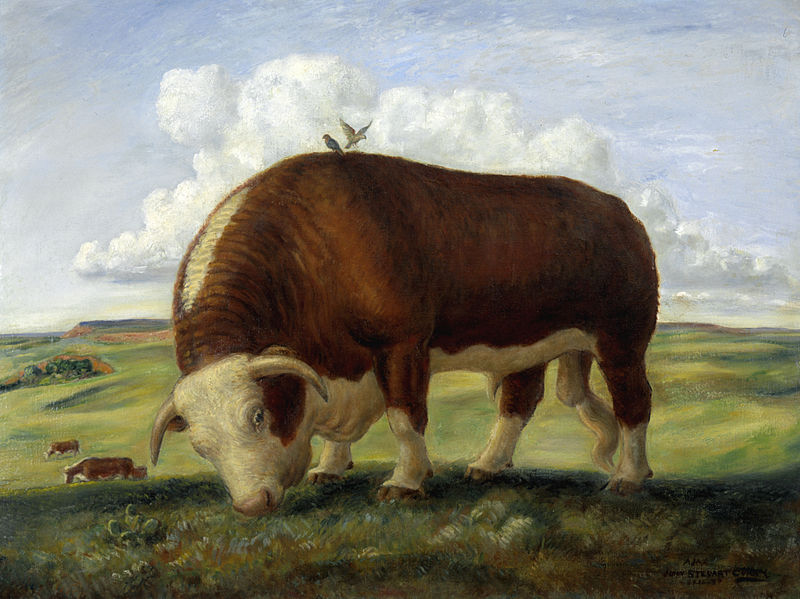<Back to Index>
- Painter John Steuart Curry, 1897
PAGE SPONSOR
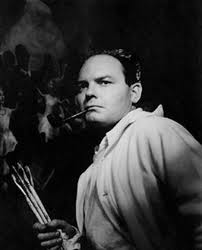
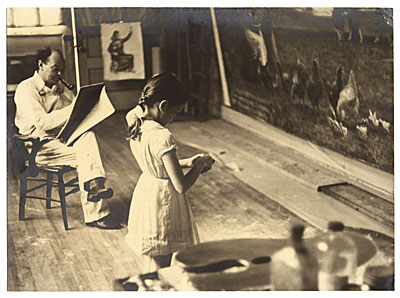
John Steuart Curry (November 14, 1897 - August 29, 1946) was an American painter whose career spanned from 1924 until his death. He was noted for his paintings depicting life in his home state, Kansas. Along with Thomas Hart Benton and Grant Wood, he was hailed as one of the three great painters of American Regionalism of the first half of the twentieth century.
Curry was born on a farm in Dunavant, Kansas, November 14, 1897. He was the eldest of five children to parents Smith and Margaret Curry. Despite growing up on a Midwestern farm, both of Curry's parents were college educated and had even visited Europe for their honeymoon. Curry's early life consisted of caring for the animals on the farm, attending the nearby high school and excelling in athletics. His childhood home was filled with many reproductions of Peter Paul Rubens and Gustav Doré, and these artist's styles played a significant role in crafting John Curry's own style.
His family was very religious as were most people in Dunavant. Curry was encouraged to paint animals around the farm and at the age of twelve he had his first art lesson. In 1916 John entered the Kansas City Art Institute, but after only a month there he transferred to the Art Institute of Chicago, where he stayed for two years. In 1918 he attended Geneva College in Beaver Falls, Pennsylvania. After he graduated, Curry worked as an illustrator from 1921-1926. He worked for several magazines including Boys' Life, St. Nicholas, County Gentleman,and The Saturday Evening Post.
In 1926 Curry spent a year in Paris studying the works of Gustave Courbet, and Honoré Daumier as well as the color techniques of Titian and Rubens. After his return to the United States he settled in New York City and married Clara Derrick, shortly thereafter they moved to Westport, Connecticut in 1924. Clara died in June 1932 and for the next two years Curry devoted his time to working in his studio. He traveled with the Ringling Brothers Circus and during his time with them created his painting The Flying Cadonas. He remarried in 1934 to Kathleen Gould. The Federal Art Project was instituted in 1934 as a way to give work to artists and alleviate the effects of the Great Depression. In 1936, Curry was appointed as the first artist in residence at the Agricultural College of the University of Wisconsin – Madison. He was free to travel throughout the state and promote art in farming communities by providing personal instruction to students. This same year he was commissioned to paint a mural for the Department of Justice Building and Main Interior Building in Washington. He was also commissioned by his home state of Kansas to paint a mural for the State Capitol at Topeka. Curry continued to work until he died of a heart attack at the age of 49 in 1946.
Curry was part of the Midwestern Triumvirate of American Regionalism which included Thomas Hart Benton and Grant Wood; these men were hailed as the three great painters of Regionalism. Regionalism was associated with the area beyond the Mississippi, mainly Iowa, Missouri and Kansas. The artists who were associated with Regionalism were concerned with rural nostalgia, and the American heartland. Regionalism was essentially a revolt against at least one major evil of the industrial revolution: centralization. Centralization of manufacturing established low cost efficient factories and assembly line production, which promoted mass production and reduced individual characteristics. Following the Wall Street Crash of 1929, the Great Depression heightened dissatisfaction with capitalism. Rugged depictions of independent life with wide open space provided distractions for those in financial crisis. According to Meyer Schapiro, "Regionalism obscured the crucial forces of history, as defined by Marx, and provided entertaining distractions from the realities facing oppressed people." Curry depicted representations of families surviving natural disaster in his man versus nature images. This theme was most certainly relevant during the Depression in the Midwest, which was thrown into economic turmoil due to lack job opportunities and income.Tornado Over Kansas reflects Curry's observance of nature and expresses his view of his home state, Kansas.
Curry was best known for his oil paintings and mural cycles. In August 1928 Curry painted Baptism in Kansas, which was exhibited at the Corcoran Gallery in Washington, D.C. The painting was praised by the New York Times and earned Curry the attention of Mrs. Gertrude Vanderbilt Whitney. In 1931 Mrs. Vanderbilt Whitney purchased the painting for the Whitney Museum of American Art in New York City, thus establishing him as a major artist. Baptism in Kansas reflected the fanatic religious sects that held open-air baptisms. These popular religious groups were part of the scene of rural life that Curry saw in Kansas. Traditional religious scenes are depicted by Curry with all the reverence one would expect from such a subject. No well known Baptismal representations by old world masters employ the unique compositional layout that Curry favors. Curry's painting was a shock to Easterners who would have never associated a baptism with full immersion or with a barn yard setting, but Curry painted what he was familiar with, as Lawrence Shmeckebrier said he "saw this scene as conceived and executed with sincere reverence and understanding of one who had lived it." Curry's religious painting is therefore an observance rather than a satire on religious fundamentalism.
Under Mrs. Whitney's patronage Curry painted Tornado Over Kansas, which depicts a farmer facing an approaching tornado while his wife helps the family and pets into the tornado shelter. The painting was unveiled in 1929 just before the Wall Street Crash in October and provided those in the city with the romance of man versus nature themes. During the 1930s Curry's work embraced the heartland of America and focused in particular on his home state of Kansas. He depicted scenes of labor, family, and land, in order to demonstrate peace, struggle, and perseverance that he had come to believe was the essence of American life. Curry's works were painted with movement which was conveyed by the free brush work and energized forms (that characterized his style.) His control over brushstrokes created excited emotions such as fear and despair in his paintings. His fellow Regionalists who also painted action and movement influenced Curry's style.
Curry's most famous works were the murals designed for the Kansas State Capitol, in Topeka, Kansas. In June 1937, newspaper editors raised money to commission John Steuart Curry (who was the most famous artist in Kansas) to paint murals in the statehouse. Curry's design was divided into three themes: first the Settlement of Kansas, which depicted the Conquistadors and the Plainsmen; second the Life of a Homesteader, which would depict John Brown; and third, Pastoral Prosperity which would include scenes of modern Kansas. Curry wanted to be free to express his own ideas regarding the murals: "I have my own ideas about telling the story of pioneers coming into Kansas. I want to paint this war with nature and I want to paint the things I feel as a native Kansan." Political controversy stalled the completion of the murals. Expensive Italian marble slabs covered the spot in the rotunda where the eight panels depicting scenes from the Life of the Kansas Homesteader were to be painted. The legislative committee refused to move them from the wall to make way for Curry's mural. However, behind the refusal were two real issues with Curry's paintings, the first being that Curry's factual details were incorrect. For instance, "they criticized the tails of his animals calling them not natural - like." In Curry's opinion, those problems could be easily fixed. However, with the next issue the committee had an even stronger objection; and that was the image of Kansan abolitionist John Brown in front of a crowd of people and a tornado. In particular, the committee objected to the blood on John Brown's hands, the prairie fires, and tornadoes. These inclusions were thought by some to show the state in a negative light due to the fact that Brown, who was executed for leading a raid on Harpers Ferry, Virginia, in 1859, was considered by some to be a traitor and a murderer. Curry tried to explain that while the blood on Brown's hands was not literal, his acts caused bloodshed, and that the tornado was a symbol of the abolitionist's passion. However, the people of Kansas saw its inclusion as a negative statement about bad weather. In his presentation to the people, Curry expressed that he wanted to get into his pictures the iron that is the Kansas people; not a soft, soppy presentation. When rejected, Curry in anger left the finished murals unsigned at his death in 1946. Since Curry's death, his murals have come to be regarded as on par with similar works done by his contemporary Thomas Hart Benton.
Curry's art in general was conservative in political content. He believed that art was for the common person. He did not believe in political propaganda, particularly the Marxist kind that Diego Rivera popularized in the 1930s. Curry avoided exploiting the controversial subjects in which Rivera became involved because, he did not believe they added any artistic quality to his work. However, Curry did create a few political sketches or studies, but these were never expanded on for larger projects. Rather, he enjoyed observing public events and capturing them on paper.
Curry's few semi - political paintings evolved out of his personal experiences rather than created as a display of social commentary. The Return of Private Davis completed in 1940 was first witnessed near his home in 1918, and a similar study was made in France during 1926. Schmeckenbier relates this painting to the Baptism: "a rural religious ceremony whose tragedy is intensified by the realization that this son of the fresh green Kansas prairies was sacrificed on a battlefield whose ideological remoteness was as dramatic as its geographical makeup." The painting does not express a political spectacle, rather Curry's personal feelings. Conversely, Parade to War depicts departing soldiers rather than the return of a victim of war. Curry was working in a time period fraught with turmoil; he was working during the Great Depression, which was flanked on each side by a World War. He was inspired by a massive anti-war sentiment that was reflected in literary works such as All Quiet on the Western Front. Curry experienced personally the effects of war and portrays personal tragedy, suffering and death in these paintings.
Along with war scenes Curry also produced a number of manhunt and fugitive subjects. These ideas were inspired by remembrances from his own childhood, but were also observed from publicized events during the early 1930s. The Lindbergh kidnapping and John Dillinger's crime spree were well known and public deaths such as lynchings were often the result of such crimes. These earlier political works would influence later Curry's mural work in the Department of Justice Building. Located "above the entrance to the Justice Department library" is Curry's painting, Law vs. Mob Rule in which a judge in black robes protects a man who has collapsed on the courthouse steps from a lynch mob.
Despite popularity among the rest of the country, native Kansans were less than thrilled with his works. What Curry believed to be images that expressed positive virtues about the place he remembered from childhood were conceived to be making fun of the worst aspects of the state. Kansans found the inclusion of outdoor baptisms and tornados to perpetuate negative stereotypes associated with Kansas and lead to public embarrassment. Curry had sought to capture the pastoral serenity of the Kansas landscape but when these paintings were displayed in New York galleries the already overwhelming inferiority complex among Kansans grew and they were humiliated by Curry's paintings. Resentment grew, as the chamber of commerce needed Curry's paintings as much as it needed other proponents of stereotypes such as the Wizard of Oz, which was released in 1939. However, New York audiences were fascinated by Curry's paintings. They were exhausted by the commercialization that surrounded their everyday lives and Curry's paintings were entertaining and allowed them to view a more primitive and isolated version of America. Only recently, with the (1992) Statehouse purchase of the drawings related to his murals has Curry's work become appreciated by residents of Kansas.
